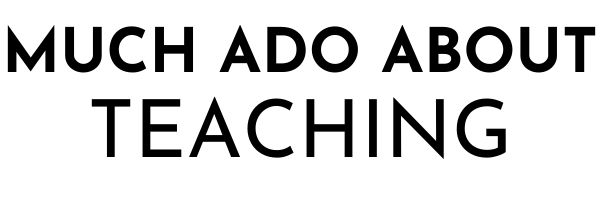Don’t you just love those teachers that are boundless wells of optimism?
You know the ones I’m talking about; they are easy to spot. They believe they can change the world from their classrooms. They teach students beyond the curriculum. They inspire them to greatness with words of wisdom. And they offer the means to be socially just and responsible.
But in this profession there are pitfalls along the way that can sap the most enthusiastic teacher and drain the life force that is necessary to sustain them.
Early in my teaching career I fell into a classic pitfall that cost me dearly.
At another district, I was expected to hand in daily lesson plans two weeks in advance. I was also coaching varsity basketball for the first time (in another district 30 miles away) and commuting an hour to work each way. I had stretched myself too thin, and consequently, I told myself that lessons planning just wasn’t that important, what really mattered was what I did in the classroom. The rapport that I had with my department chair was taken for granted and I used it to turn in shoddy lesson plans. I knew they were of poor quality, and it did not help that they were often late, but I was banking on not getting caught.
And of course, I did.
It was my first major mistake as a teacher.
I spent the rest of the year trying to get out of the doghouse, but to no avail. From then on, every lesson plan was put through the ringer. Administrators began “popping in” to evaluate me. I never felt comfortable in my own classroom and I never recovered that year.
I had made myself miserable because I fooled myself into believing that I could wing it.
That year hurt me and my optimism because it made me wary of administrators, skeptical of detailed, advanced lesson plans, and bitter for being in the hot seat.
I was only able to recover by transforming my teaching. I began to put time and thought into planning dynamic lessons. I devoted new energy into being prepared. And I invited administrators into my room rather than fear their presence.
Teacher Pitfalls
Nearly every guest that has appeared on my old podcast, Talks with Teachers, shared a moment of failure. I repeatedly ask this question because we all need to hear that even the most decorated teachers — like the National Teachers of the Year — have had blunders in the classroom, lessons that have backfired, and mistakes along the way.
I’m here to reassure you that it is bound to happen to all of us. No teacher can be perfect all day, everyday. But we can recognize the most common teacher pitfalls, anticipate them, and stave them off so that we can retain that optimism and youthful energy that propelled us in the classroom initially.
Here are four common teacher pitfalls and resources that will help you avoid them.
1. You Try to be Someone Else, Not Yourself
Why it happens:
You see other teachers succeeding with a distinctive style and you try to copy them. Perhaps it is a bit of envy, perhaps it is a need to reinvent yourself, or it can just be a result of not having confidence in your voice as a teacher. Regardless, you mimic someone else, hoping to capture their magic.
Why it is a Pitfall:
Students are adept at detecting authenticity and know our true selves, sometimes better than we do. They are perceptive when we try too hard to be the cool teacher, the strict teacher, the sarcastic teacher, and anything and everything in between. It is a quick way to alienate students and weaken classroom rapport.
While we can certainly admire the positive attributes of colleagues, and work to incorporate them into our own classrooms, we cannot be carbon copies of them. We must adopt and infuse these elements with our own personalities to remain true to ourselves and true for our students.
How to Avoid it:
Read — The 2 Keys to Authentic Leadership — Self Awareness and Integrity by Brad Parcells
Integrity is both personal and moral. Personal integrity is when you are authentically the person you were created to be. It means living a life of wholeness, congruence and without regret. Moral integrity is when you do what is right simply because you know it is the right thing to do. It means living a life of character and virtue. Integrity takes both. Leadership takes both. Authenticity and integrity go hand in hand.
2. You Teach the Way You Were Taught
Why it Happens:
Repeating what has already done is a lot easier than being original. So if you had teachers that made a lot of packets and kept you busy with worksheets all period, and it worked then, you believe it will work now. Maybe it’s not packets, maybe it is notebook checks, or popcorn reading. These all might be great practices, but they may also fall short. But if a teacher limits himself or herself by teaching the way they were taught, they close the door to new possibilities.
Why it is a Pitfall:
Good teachers are constantly on the lookout for good teaching practices to benefit their students. It is irrelevant is the instructional method occurred 20 years ago in a class they took as a student or if it was discussed in an EdCamp over the weekend. What matters most is — will it work for your students in your situation?
Simply repeating the past is not a guarantee of success. One of the most dangerous phrases a teacher can say is, “Well, it worked when I was a student, I don’t see why it won’t work now.”
How to Avoid it:
Buy and repeatedly read Dave Burgess’ Teach Like a Pirate: Increase Student Engagement, Boost Your Creativity, and Transform Your Life as an Educator. It is the best book to get you thinking out of the box as a teacher.
“We need risk-takers, outside-the-box thinkers, and entrepreneurs; our school systems do the next generation a great disservice by discouraging these very skills and attitudes. Instead of helping and encouraging them to find and develop their unique strengths, they’re told to shut up, put the cell phones away, memorize these facts and fill in the bubbles.”
3. You Listen to the Negative Voices in the Faculty Room… Or Worse, You Become One
Why it Happens:
All teachers should be sociable and interact with colleagues. But every time a faculty member says that students aren’t interested in learning, every time they mention that no one takes homework seriously, or every time they talk about how much they are on those damned cell phones, your optimism may suffer. It doesn’t happen immediately. Each comment is a small peck made in the foundation. But slowly those pecks create cracks that can rock the core.
Why it is a Pitfall:
Researchers discovered that it takes a minority of just five percent to influence a crowd’s direction – and that the other 95 percent follow without realizing it.
Another series of experiments concluded that when people didn’t have a strong opinion about the choices presented to them, they simply mimicked the people around them. Rather than asking questions, or spending time learning, people deferred to the “social default.”
How to Avoid it:
This is one way any teacher can be a teacher-leader. You can be the five percent that influences the other 95 percent in the right direction.
You can creative a positive environment by using these simple conversation starters:
- What’s working in your classroom right now?
- Which students are you really proud of recently?
- What you looking forward excited to teach next?
Most will respond with optimistic answers. Conversations that once veered toward the negative can be redirected in positive directions and the tone of an entire building can change if the 5 percent does its part.
Be the 5 percent.
4. You Teach to the Test
Why it Happens:
We all know why it happens — there is a tremendous pressure on teachers to get results.
It can come from any number of directions — board members, administrators, politicians, and all too often — ourselves. Consequently, in order to fully prepare students for the big exam, we give students more test preparation than is necessary.
We force our students to digest a steady diet of practice tests. We breakdown and chart each multiple-choice question. We overanalyze the data. And we mimic the high-stakes of the exam by putting pressure on students to perform with hefty quarterly and mid-term exams.
Why it is a Pitfall:
Research shows that high-quality classroom based assessment, linked to corrective instruction, can significantly improve the quality of learning, perhaps more than other kinds of teaching intervention.
The more we “drill and kill” the less curiosity, fascination, and wonder we will create. And students can not achieve be propelled to deep, lasting learning without those three ingredients.
How to Avoid it:

As Make It Stick: The Science of Successful Learning advocates, low-stakes practice that is spaced between rich and impactful lessons produces better long-term results than shutting down the curriculum a month before the big exam to do test preparation.
Make It Stick has had the biggest impact on my approach to AP Literature and Composition, helping improve my results by 30% in a five-year period. It taught me that students need practice, not more tests. They need that practice spaced out, allowing them to slightly forget the material, so that by recalling it, it will strengthen the connections. And that practice should be rich and varied, not repetitive.
“Practice that’s spaced out, interleaved with other learning, and varied produces better mastery, longer retention, and more versatility… It’s widely believed by teachers, trainers, and coaches that the most effective way to master a new skill is to give it dogged, single-minded focus, practicing over and over until you’ve got it down. Our faith in this runs deep, because most of us see fast gains during the learning phase of massed practice. What’s apparent from the research is that gains achieved during massed practice are transitory and melt away quickly.”














One comment
Cindy Dixon
Thank you for these reminders. I took on AP Lang this year as an additional prep to my AP Lit and American Lit . The learning curve hit me hard, but I know I’ll make it if I just stick with it. It’s so easy to fall into any of these pitfalls.